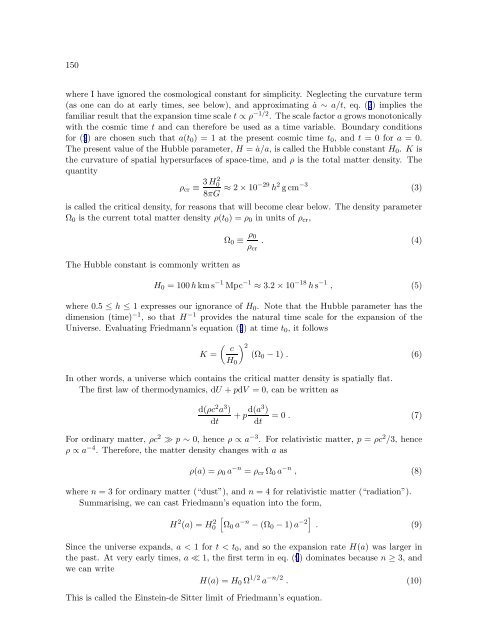Proc. Neutrino Astrophysics - MPP Theory Group
Proc. Neutrino Astrophysics - MPP Theory Group
Proc. Neutrino Astrophysics - MPP Theory Group
You also want an ePaper? Increase the reach of your titles
YUMPU automatically turns print PDFs into web optimized ePapers that Google loves.
150<br />
where I have ignored the cosmological constant for simplicity. Neglecting the curvature term<br />
(as one can do at early times, see below), and approximating ˙a ∼ a/t, eq. (2) implies the<br />
familiar result that the expansion time scale t ∝ ρ −1/2 . The scale factor a grows monotonically<br />
with the cosmic time t and can therefore be used as a time variable. Boundary conditions<br />
for (2) are chosen such that a(t0) = 1 at the present cosmic time t0, and t = 0 for a = 0.<br />
The present value of the Hubble parameter, H = ˙a/a, is called the Hubble constant H0. K is<br />
the curvature of spatial hypersurfaces of space-time, and ρ is the total matter density. The<br />
quantity<br />
ρcr ≡ 3H2 0<br />
8πG ≈ 2 × 10−29 h 2 g cm −3<br />
is called the critical density, for reasons that will become clear below. The density parameter<br />
Ω0 is the current total matter density ρ(t0) = ρ0 in units of ρcr,<br />
The Hubble constant is commonly written as<br />
Ω0 ≡ ρ0<br />
ρcr<br />
(3)<br />
. (4)<br />
H0 = 100hkm s −1 Mpc −1 ≈ 3.2 × 10 −18 hs −1 , (5)<br />
where 0.5 ≤ h ≤ 1 expresses our ignorance of H0. Note that the Hubble parameter has the<br />
dimension (time) −1 , so that H −1 provides the natural time scale for the expansion of the<br />
Universe. Evaluating Friedmann’s equation (2) at time t0, it follows<br />
�<br />
c<br />
K =<br />
H0<br />
� 2<br />
(Ω0 − 1) . (6)<br />
In other words, a universe which contains the critical matter density is spatially flat.<br />
The first law of thermodynamics, dU + pdV = 0, can be written as<br />
d(ρc 2 a 3 )<br />
dt<br />
+ p d(a3 )<br />
dt<br />
= 0 . (7)<br />
For ordinary matter, ρc 2 ≫ p ∼ 0, hence ρ ∝ a −3 . For relativistic matter, p = ρc 2 /3, hence<br />
ρ ∝ a −4 . Therefore, the matter density changes with a as<br />
ρ(a) = ρ0 a −n = ρcr Ω0 a −n , (8)<br />
where n = 3 for ordinary matter (“dust”), and n = 4 for relativistic matter (“radiation”).<br />
Summarising, we can cast Friedmann’s equation into the form,<br />
H 2 (a) = H 2 0<br />
�<br />
Ω0 a −n − (Ω0 − 1)a −2�<br />
. (9)<br />
Since the universe expands, a < 1 for t < t0, and so the expansion rate H(a) was larger in<br />
the past. At very early times, a ≪ 1, the first term in eq. (9) dominates because n ≥ 3, and<br />
we can write<br />
H(a) = H0 Ω 1/2 a −n/2 . (10)<br />
This is called the Einstein-de Sitter limit of Friedmann’s equation.













